佛教英语
- 格式:doc
- 大小:42.00 KB
- 文档页数:4
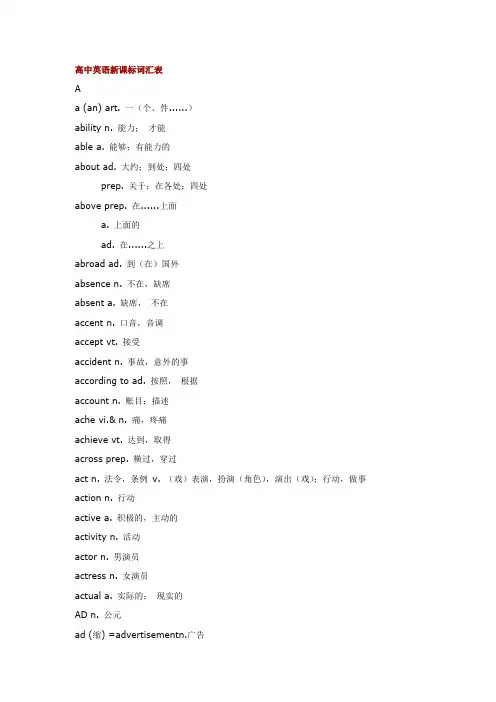
高中英语新课标词汇表Aa (an) art. 一(个、件......)ability n. 能力;才能able a. 能够;有能力的about ad. 大约;到处;四处 prep. 关于;在各处;四处above prep. 在......上面 a. 上面的 ad. 在......之上abroad ad. 到(在)国外absence n. 不在,缺席absent a. 缺席,不在accent n. 口音,音调accept vt. 接受accident n. 事故,意外的事according to ad. 按照,根据account n. 账目;描述ache vi.& n. 痛,疼痛achieve vt. 达到,取得across prep. 横过,穿过act n. 法令,条例v. (戏)表演,扮演(角色),演出(戏);行动,做事action n. 行动active a. 积极的,主动的activity n. 活动actor n. 男演员actress n. 女演员actual a. 实际的;现实的AD n. 公元ad (缩) =advertisementn.广告addvt.添加,增加addition n. 增加;(算数用语)加address n. 地址admire v. 钦佩;羡慕admission n. 准入, 接纳admit vt. 承认,准许(入场,入学,入会)adult n. 成年人advance v. 推进,促进;前进advantage n. 优点;好处adventure n. 冒险;奇遇advertise vt. 为......做广告advertisement n. 广告advice n. 忠告,劝告,建议advise vt. 忠告,劝告,建议aeroplane n. (英)飞机affair n. 事,事情affect vt. 影响afford vt. 负担得起(......的费用);抽得出(时间);提供afraid a. 害怕的;担心Africa* n. 非洲African a. 非洲的,非洲人的n. 非洲人after ad. 在后;后来prep. 在......之后;在后面 conj. 在......以后 afternoon n. 下午,午后afterwards ad. 后来again ad. 再一次;再,又against prep. 对着,反对age n. 年龄;时代aggression n. 侵略aggressive a. 侵略的;咄咄逼人的ago ad. 以前agree v. 同意;应允agreement n. 同意,一致;协定,协议agricultural a. 农业的agriculture n. 农业,农学ahead ad. 在前,向前aid n. 援助;救护;辅助器具AIDS n. 艾滋病aim n.目的;目标v. 计划,打算;瞄准;针对air n. 空气;大气aircraft n. 飞机(单复数同)airline n. 航空公司;航空系统airmail n. 航空邮件airplane n. (美)飞机airport n. 航空站,飞机场alarm n. 警报alive a. 活着的,存在的all ad. 全部地a. 全(部);所有的;总;整 pron. 全部;全体人员allow vt. 允许,准许almost ad. 几乎,差不多alone a. 单独的,孤独的along ad. 向前;和......一起;一同prep. 沿着;顺着aloud ad. 大声地already ad. 已经also ad. 也although conj. 虽然,尽管altogether ad. 总共always ad. 总是;一直;永远am v. be的人称形式之一a.m./am,A.M./AM n. 午前,上午amaze v.惊奇,惊叹;震惊ambulance n. 救护车America* n. 美国;美洲American a. 美国的;美国人的n. 美国人among prep. 在...中间;在(三个以上)之间amuse vt. (使人)快乐,逗乐amusement n. 娱乐ancient a. 古代的,古老的ancestor n. 祖宗;祖先and conj. 和;又;而anger n. 怒,愤怒angry a. 生气的,愤怒的animal n. 动物announce vt. 宣布,宣告announcement n. 通告,通知annoy vt. (使)烦恼another a. 再一;另一;别的;不同的pron. 另一个answer n. 回答,答复;回信;答案v. 回答,答复;回信;(作出)答案ant n. 蚂蚁Antarctic a. 南极的the Antarctic 南极Antarctica* n. 南极洲antique n. 古董anxious a. 忧虑的,焦急的any pron. (无论)哪一个;哪些任何的;(用于疑问句、否定句)一些;什么anybody pron. 任何人,无论谁anyhow ad. 不管怎样anyone pron. 任何人,无论谁anything pron. 什么事(物);任何事(物)anyway ad. 不管怎样anywhere ad. 任何地方apartment n. (美)楼中单元房,一套房间;房间apologize vi. 道歉,谢罪apology n. 道歉;歉意appear vi. 出现appearance n. 出现,露面;容貌apple n. 苹果application n. 申请apply v. 申请appointment n. 约会appreciate v. 欣赏;感激April n. 4月Arab* a. 阿拉伯的n. 阿拉伯人Arabic a. 阿拉伯语的n. 阿拉伯语Arctic a. 北极的the Arctic 北极the Arctic Ocean 北冰洋area n. 面积;地域,地方,区域;范围,领域argue vi. 争辩,争论argument n. 争论,辩论arise (arose, arisen) vi. 起来,升起;出现arithmetic n. 算术arm1 n. 臂, 支架arm2 v. 以......装备,武装起来n. (美)武器,武力armchair n. 扶手椅army n. 军队around ad. 在周围;在附近prep. 在......周围;大约arrange v. 安排,布置arrangement n. 安排,布置arrival n. 到来,到达arrive vi. 到达;达到arrow n. 箭;箭头art n. 艺术,美术;技艺article n. 文章;东西,物品;冠词artistn.艺术家as ad.& conj. 像......一样;如同;因为prep. 作为,当做ash n. 灰;灰末ashamed a. 惭愧;害臊Asia* n. 亚洲Asian a. 亚洲的,亚洲人的n. 亚洲人aside ad. 在旁边ask v. 问,询问;请求,要求;邀请asleep a. 睡着的,熟睡assistant n. 助手,助理astonish vt. 使惊讶astronaut n. 宇航员astronomy n. 天文学at prep. 在(几点钟);在(某处)athlete n. 运动员Atlantic a. 大西洋的the Atlantic Ocean大西洋atmosphere n. 大气;气氛atom n. 原子,微粒attack vt. 攻击,袭击attempt vt. 试图,尝试attend v. 看护,照料,服侍;出席,参加attention n. 注意,关心attentively ad. 注意地attitude n. 态度,看法attract v. 吸引,引起attractive a. 迷人的,有吸引力的audience n. 观众,听众author n. 作者,作家August n. 8月aunt n. 伯母;舅母;婶;姑;姨Australia* n. 澳洲;澳大利亚Australian a. 澳洲的,澳大利亚人的n. 澳大利亚人autumn n. 秋天,秋季avenue n. 大道average a. 平均的;普通的n. 平均数avoid v. 避免,躲开,逃避awake (awoke, awo ken) v. 唤醒醒着的ward n. 奖品,奖励away ad. 离开;远离Bbaby n. 婴儿back ad. 回(原处);向后a. 后面的n. 背后,后部;背backache n. 背痛background n. 背景backward(s) ad. 向后bacon n. 咸猪肉;熏猪肉bacterium (复bacteria) n. 细菌bad (比较级worse, 最高级worst) a. 坏的;有害的,不利的;严重的badly ad. 坏,恶劣地badminton n. 羽毛球bag n. 书包;提包;袋子baggage n. 行李bake v. 烤;烘(面包)bakery n. 面包店balance n. 平衡balcony n. 阳台;楼座ball1 n. 球ball2 n. 舞会ballet n. 芭蕾舞balloon n. 气球ballpoint = ballpoint pen n. 圆珠笔bamboo n. 竹ban n. 禁令v. 禁止;取缔banana n. 香蕉bandage n. 绷带bang int. 砰bank1 n. (河、海、湖的)岸,堤bank2 n. 银行bank account n. 银行账户bar1 n. 条;(长方)块,棒,横木〖〗bar2 n. (酒店的)买酒柜台;酒吧;(卖东西的)柜台barbecue n. 烤肉野餐barber n. (为男人理发的)理发师barbershop n. 理发店bargain n. (经讨价还价之后)成交的商品;廉价货v. 讨价还价bark v. 狗叫n. 狗叫声basen. 根据地,基地;(棒球)垒baseball n. 棒球basement n. 地下室basic a. 基本的basin n. 水盆,脸盆basket n. 篮子basketball n. 篮球bat1 n. (棒球、板球的)球棒bat2 n. 蝙蝠bath n. 洗澡;浴室;澡盆bathe vi. 洗澡;游泳bathrobe n. 浴衣bathroom n. 浴室,盥洗室bathtub n. 澡盆battery n. 电池battle n. 战斗;战役battleground n. 战场bay n. 湾;海湾BC n. 公元前be v. 是(原形),其人称和时态形式有am, is, are, was, were, being, been;成为beach n. 海滨,海滩beam n. 平衡木bean n. 豆,豆科植物beancurd n. 豆腐bear1 v. 承受,负担,承担;忍受;容忍bear2 n. 熊beard n. (下巴上的)胡须beast n. 野兽;牲畜beat (beat, beaten) v. 敲打;跳动;打赢n. (音乐)节拍beautiful a. 美的,美丽的,美观的beauty n. 美丽,美人because conj. 因为become (became, be come) v. 变得;成为bed n. 床bedclothes n. 铺盖(被褥等)bedroom n. 寝室,卧室bee n.. 蜜蜂beef n. 牛肉beehive n. 蜂箱beer n. 啤酒before prep. 在......以前;在......前面 ad. 以前 conj. 在......之前 beg v. 请求,乞求,乞讨begin(began,begun) v. 开始,着手beginning n. 开始,开端behave v. 守规矩,行为behaviour n. 行为,举止behind prep. (表示位置)在......后面ad. 在后面;向后Beijingn. 北京being n. 物;生物;人Belgium* n. 比利时belief n. 信条,信念believe v. 相信,认为bell n. 钟,铃;钟(铃)声;钟形物belly n. 肚子belong vi. 属,附属below prep. 在......下面belt n. (皮)带bench n. 长凳;工作台bend (bent, bent) vt. 使弯曲beneath prep. 在......下方(面)bent a. 弯的beside prep. 在......旁边;靠近besides prep. 除......以外(还有)ad. 还有,此外best(good, well的最高级) a. & ad. 最好的;最好地,最n. 最好的(人或物)best seller n. 畅销书better (good, well的比较级) a.& ad. 较好的,更好的;好些;更好地;更,更多n. 较好的事物;较优者v. 改善;胜过between prep. 在(两者)之间;在......中间beyond prep. (表示位置) 在......的那边bicycle n. 自行车big a. 大的bike = bicyclen. 自行车bill n.账单;法案,议案;(美)钞票,纸币billion num. 十亿,百亿biology n. 生物(学)bird n. 鸟birdcage n. 鸟笼birth n. 出生;诞生birthday n. 生日birthplace n. 出生地;故乡biscuit n. 饼干bit n. 一点,一些,少量的bite (bit, bitten) v. 咬;叮bitter a. 有苦味的;痛苦的,难过的;严酷的black n. 黑色a. 黑色的blackboard n. 黑板blame n.& v. 责备;责怪blank n.& a. 空格,空白(处);空的;茫然无表情的blanket n. 毛毯,毯子bleed vi. 出血,流血bless vt. 保佑,降福blind a. 瞎的block n. 大块;(木、石等)块;街区;路障vt. 阻塞;阻挡blood n. 血,血液blouse n. 宽罩衫;(妇女、儿童穿的)短上衣blow n. 击;打击blow (blew, blown) v. 吹;刮风;吹气blue1 n. 蓝色a.蓝色的blue2 a. 悲伤的;沮丧的board n. 木板;布告牌;委员会;(政府的)部v. 上(船、火车、飞机)boat n. 小船,小舟boat race n. 划船比赛boating n. 划船(游玩),泛舟body n. 身体body building n. 健美boil v. 沸腾;烧开;煮......bomb n. 炸弹v. 轰炸bone n. 骨头,骨质(复数bones骨骼;骨骸)book n. 书;本子v. 预定,定(房间、车票等)bookcase n. 书橱bookmark n. 书签bookshelf n. 书架bookshop n. 书店bookstore n. 书店boot n. 长统靴;靴booth telephone booth n.岗;(为某种用途而设的)亭或小隔间电话亭border n. 边缘;边境,国界boring a. 乏味的,无聊的born a. 出生borrow v. (向别人)借用;借boss n. 领班;老板botany n. 植物;植物学both a. 两;双pron. 两者;双方bottle n. 瓶子bottom n. 底部;底bound1 a. 被束缚的;被绑的;有义务的bound2 v.& n. 跳跃bow v.& n. 鞠躬,弯腰行礼bowl n. 碗box n. 盒子,箱子boxing n. 拳击(运动)boy n. 男孩brain n. 脑(子)brake n. 闸vi. 刹车branch n. 树枝;分枝;分公司,分店;支部brave a. 勇敢的bravery n. 勇气bread n. 面包break n. 间隙break (broke, bro ken) v. 打破(断,碎);损坏,撕开breakfast n. 早餐breath n. 气息;呼吸breathe vi. 呼吸brick n. 砖;砖块bride n. 新娘bridegroom n. 新郎bridge n. 桥brief a. 简洁的bright a. 明亮的;聪明的bring (brought, brought) vt. 拿来,带来,取来Britain* n. 英国;不列颠British a. 英国的;大不列颠的;英国人的the British n. 英国国民;大不列颠人broad a. 宽的,宽大的broadcast n. 广播节目broadcast(broadcast, broadcast或 ed, ed) vt. 广播broken a. 弄坏了的broom n. 扫帚brother n. 兄;弟brotherhood n. 兄弟般的关系brown n. 褐色,棕色a. 褐色的,棕色的brunch n. 早午饭(晚早饭)brush v. 刷;擦n. 刷子bucket n. 铲斗;桶Buddhism n. 佛教Buddhist n. 佛教徒build (built, built) v. 建筑;造building n. 建筑物;房屋;大楼bun n. 馒头;小甜面包burial n. 埋葬burn ( ed, ed 或burnt, burnt) v. 燃,烧,着火;使烧焦;使晒黑n. 烧伤;晒伤burst v. 突然发生;突然发作bury vt. 埋;葬bus bus stop n. n. 公共汽车公共汽车站bush n. 灌木丛,矮树丛business n. (本分)工作,职业;职责;生意,交易;事业businessman n. 商人(男);男企业家businesswoman n. 商人(女);女企业家busy a. 忙(碌)的but conj. 但是,可是prep. 除了,除......外butcher n. vt. 肉店;屠夫屠宰(动物);残杀(人)butter n. 黄油,奶油butterfly n. 蝴蝶the butterfly蝶泳button n. 纽扣;(电铃等的)按钮v. 扣(纽扣)buy(bought,bought) vt. 买by prep. 靠近,在......旁;在......时间;不迟于;被;用;由;乘(车)bye int. 再见。
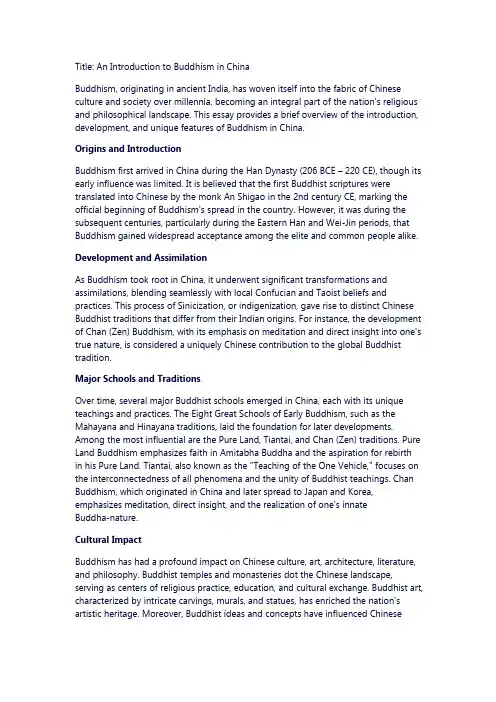
Title: An Introduction to Buddhism in ChinaBuddhism, originating in ancient India, has woven itself into the fabric of Chinese culture and society over millennia, becoming an integral part of the nation's religious and philosophical landscape. This essay provides a brief overview of the introduction, development, and unique features of Buddhism in China.Origins and IntroductionBuddhism first arrived in China during the Han Dynasty (206 BCE – 220 CE), though its early influence was limited. It is believed that the first Buddhist scriptures were translated into Chinese by the monk An Shigao in the 2nd century CE, marking the official beginning of Buddhism's spread in the country. However, it was during the subsequent centuries, particularly during the Eastern Han and Wei-Jin periods, that Buddhism gained widespread acceptance among the elite and common people alike. Development and AssimilationAs Buddhism took root in China, it underwent significant transformations and assimilations, blending seamlessly with local Confucian and Taoist beliefs and practices. This process of Sinicization, or indigenization, gave rise to distinct Chinese Buddhist traditions that differ from their Indian origins. For instance, the development of Chan (Zen) Buddhism, with its emphasis on meditation and direct insight into one's true nature, is considered a uniquely Chinese contribution to the global Buddhist tradition.Major Schools and TraditionsOver time, several major Buddhist schools emerged in China, each with its unique teachings and practices. The Eight Great Schools of Early Buddhism, such as the Mahayana and Hinayana traditions, laid the foundation for later developments. Among the most influential are the Pure Land, Tiantai, and Chan (Zen) traditions. Pure Land Buddhism emphasizes faith in Amitabha Buddha and the aspiration for rebirth in his Pure Land. Tiantai, also known as the "Teaching of the One Vehicle," focuses on the interconnectedness of all phenomena and the unity of Buddhist teachings. Chan Buddhism, which originated in China and later spread to Japan and Korea, emphasizes meditation, direct insight, and the realization of one's innateBuddha-nature.Cultural ImpactBuddhism has had a profound impact on Chinese culture, art, architecture, literature, and philosophy. Buddhist temples and monasteries dot the Chinese landscape, serving as centers of religious practice, education, and cultural exchange. Buddhist art, characterized by intricate carvings, murals, and statues, has enriched the nation's artistic heritage. Moreover, Buddhist ideas and concepts have influenced Chineseliterature, particularly in the form of poetry and prose, where themes of enlightenment, impermanence, and compassion are frequently explored. ConclusionBuddhism in China is a testament to the resilience and adaptability of religious traditions as they traverse geographical and cultural boundaries. Through centuries of assimilation and innovation, Buddhism has become an inseparable part of Chinese identity, shaping the nation's spiritual landscape and contributing to its rich cultural heritage. Today, Buddhism continues to inspire millions of people in China and around the world, offering a path to enlightenment, peace, and harmony.。
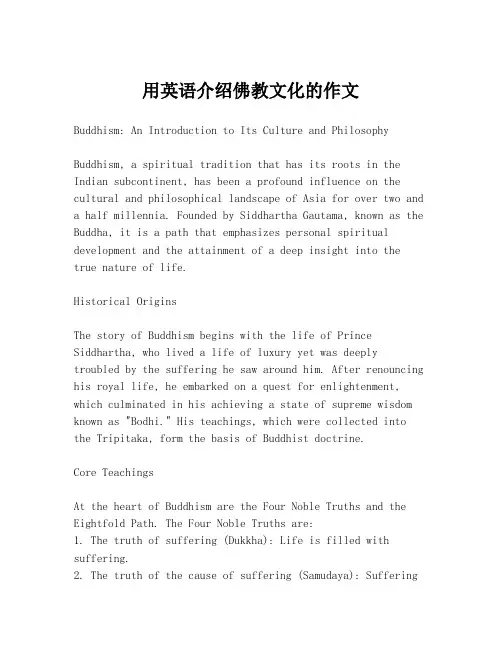
用英语介绍佛教文化的作文Buddhism: An Introduction to Its Culture and PhilosophyBuddhism, a spiritual tradition that has its roots in the Indian subcontinent, has been a profound influence on the cultural and philosophical landscape of Asia for over two and a half millennia. Founded by Siddhartha Gautama, known as the Buddha, it is a path that emphasizes personal spiritual development and the attainment of a deep insight into the true nature of life.Historical OriginsThe story of Buddhism begins with the life of Prince Siddhartha, who lived a life of luxury yet was deeply troubled by the suffering he saw around him. After renouncing his royal life, he embarked on a quest for enlightenment, which culminated in his achieving a state of supreme wisdom known as "Bodhi." His teachings, which were collected into the Tripitaka, form the basis of Buddhist doctrine.Core TeachingsAt the heart of Buddhism are the Four Noble Truths and the Eightfold Path. The Four Noble Truths are:1. The truth of suffering (Dukkha): Life is filled with suffering.2. The truth of the cause of suffering (Samudaya): Sufferingis caused by craving and attachment.3. The truth of the end of suffering (Nirodha): It ispossible to end suffering by overcoming craving and attachment.4. The truth of the path leading to the end of suffering (Magga): The Eightfold Path is the way to achieve this end.The Eightfold Path consists of right understanding, right intention, right speech, right action, right livelihood,right effort, right mindfulness, and right concentration. These practices are designed to help individuals achieve enlightenment and liberation from the cycle of rebirth knownas Samsara.Cultural ImpactBuddhism has had a significant impact on the arts, literature, and daily life in countries such as India, China, Japan, Thailand, and many others. Buddhist art, including statues of the Buddha, mandalas, and thangka paintings, often serve as a focus for meditation and are rich in symbolic meaning. Buddhist literature encompasses a vast array of texts, fromthe sutras to the philosophical treatises of various schoolsof thought.Meditation and MindfulnessCentral to Buddhist practice is meditation, which is seen asa means to calm the mind and gain insight into the nature of reality. Mindfulness, a concept that has gained popularity in the West, originates from Buddhist teachings and involvespaying close attention to the present moment without judgment.Buddhism TodayToday, Buddhism continues to evolve and adapt to modern society. It has spread beyond its Asian origins to become a global religion with millions of followers. The teachings of Buddhism offer a path to inner peace and ethical living that resonates with many in a world that is often chaotic and stressful.In conclusion, Buddhism is not just a religion but a way oflife that has provided countless individuals with a framework for understanding the world and for achieving personal transformation. Its teachings on compassion, wisdom, and the interconnectedness of all beings continue to inspire andguide those who seek a deeper understanding of life's complexities.。
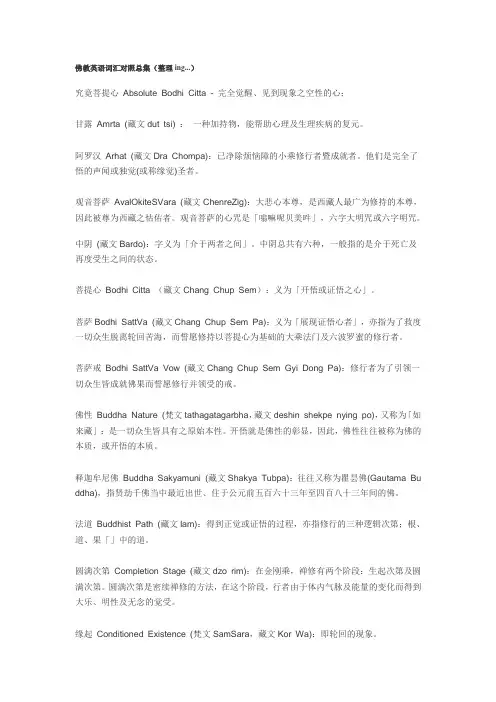
佛教英语词汇对照总集(整理ing...)究竟菩提心Absolute Bodhi Citta - 完全觉醒、见到现象之空性的心;甘露Amrta (藏文dut tsi) :一种加持物,能帮助心理及生理疾病的复元。
阿罗汉Arhat (藏文Dra Chompa):已净除烦恼障的小乘修行者暨成就者。
他们是完全了悟的声闻或独觉(或称缘觉)圣者。
观音菩萨AvalOkiteSVara (藏文ChenreZig):大悲心本尊,是西藏人最广为修持的本尊,因此被尊为西藏之怙佑者。
观音菩萨的心咒是「嗡嘛呢贝美吽」,六字大明咒或六字明咒。
中阴(藏文Bardo):字义为「介于两者之间」。
中阴总共有六种,一般指的是介于死亡及再度受生之间的状态。
菩提心Bodhi Citta (藏文Chang Chup Sem):义为「开悟或证悟之心」。
菩萨Bodhi SattVa (藏文Chang Chup Sem Pa):义为「展现证悟心者」,亦指为了救度一切众生脱离轮回苦海,而誓愿修持以菩提心为基础的大乘法门及六波罗蜜的修行者。
菩萨戒Bodhi SattVa Vow (藏文Chang Chup Sem Gyi Dong Pa):修行者为了引领一切众生皆成就佛果而誓愿修行并领受的戒。
佛性Buddha Nature (梵文tathagatagarbha,藏文deshin shekpe nying po),又称为「如来藏」:是一切众生皆具有之原始本性。
开悟就是佛性的彰显,因此,佛性往往被称为佛的本质,或开悟的本质。
释迦牟尼佛Buddha Sakyamuni (藏文Shakya Tubpa):往往又称为瞿昙佛(Gautama Bu ddha),指贤劫千佛当中最近出世、住于公元前五百六十三年至四百八十三年间的佛。
法道Buddhist Path (藏文lam):得到正觉或证悟的过程,亦指修行的三种逻辑次第;根、道、果「」中的道。
圆满次第Completion Stage (藏文dzo rim):在金刚乘,禅修有两个阶段:生起次第及圆满次第。
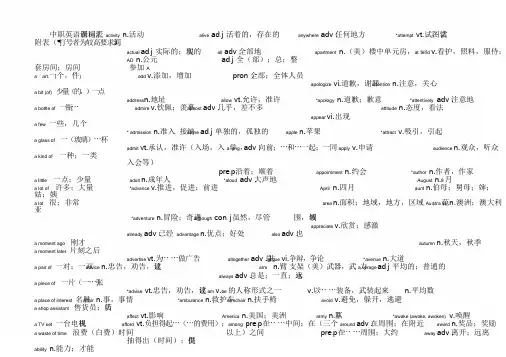
表activity n.活动alive ad.j活着的,存在的anywhere adv任. 何地方*attempt vt.试图,尝试词汇中职英语新课标)附表(*打号者为较高要求词汇actual ad.j实际的;现实的all adv全.部地apartment n.(美)楼中单元房,at一t end v.看护,照料,服侍;AD n.公元ad.j全(部);总;整套房间;房间参加Aa art.一(个,件) add v.添加,增加pron全. 部;全体人员apologize vi.道歉,谢罪a ttention n.注意,关心a bit (of) 少量(的,)一点address n.地址allow vt.允许,准许*apology n.道歉;歉意*attentively adv注.意地a bottle of 一瓶⋯admire v.钦佩;羡慕a lmost adv几.乎,差不多attitude n.态度,看法appear vi.出现a few 一些,几个* admission n.准入, 接纳a lone ad.j单独的,孤独的apple n.苹果*attract v.吸引,引起a glass of 一(玻璃)⋯杯admit vt.承认,准许(入场,入a学long,adv向.前;⋯和⋯一起;一同apply v.申请audience n.观众,听众a kind of 一种;一类入会等)pre.p沿着;顺着appointment n.约会*author n.作者,作家a little 一点;少量adult n.成年人*aloud adv大.声地August n.8月a lot of 许多;大量*advance v.推进,促进;前进April n.四月aunt n.伯母;舅母;婶;姑;姨a lot 很;非常area n.面积;地域,地方,区域Au;stra范l ia n.澳洲;澳大利亚*adventure n.冒险;奇遇a lthough con. j虽然,尽管围,领域appreciate v.欣赏;感激already adv已. 经advantage n.优点;好处also adv也.a moment ago 刚才autumn n.秋天,秋季a moment later 片刻之后advertise vt.为⋯⋯做广告altogether adv总.共a rgue vi.争辩,争论*avenue n.大道a pair of 一对;一双a dvice n.忠告,劝告,建议arm n.臂, 支架(美)武器,武a力verage ad.j平均的;普通的always adv总.是;一直;永远a piece of 一片(一⋯张)*advise vt.忠告,劝告,建议am v.be的人称形式之一v.以⋯⋯装备,武装起来n.平均数a place of interest 名胜a ffair n.事,事情*ambulance n.救护车a rmchair n.扶手椅avoid v.避免,躲开,逃避a shop assistant 售货员;店员affect vt.影响America n.美国;美洲army n.军队*awake (awoke, awoken) v.唤醒a TV set 一台电视机afford vt.负担得起⋯(⋯的费用);among pre.p在⋯⋯中间;在(三个around adv在.周围;在附近award n.奖品;奖励a waste of time 浪费(白费)时间以上)之间pre.p在⋯⋯周围;大约away adv离.开;远离供抽得出(时间);提ability n.能力;才能afraid ad.j害怕的;担心amuse vt(.使人)快乐,逗乐arrange v.安排,布置Bable ad.j能够;有能力的arrest v.n.逮捕be able to 能;会Africa n.非洲ancient ad.j古代的,古老的about adv大.约;到处;四处be afraid of 害怕after adv在.后;后来and con. j和;又;而*arrival n.到来,到达pre.p关于;在各处;四处pre.p在⋯⋯之后;⋯在⋯后面*anger n.怒,愤怒arrive vi.到达;达到be amazed at 对...感到惊讶above pre.p在⋯⋯上面angry ad.j生气的,愤怒的art n.艺术,美术;技艺be angry with 对某人发脾气 con. j在⋯⋯以后ad.j上面的be awake 醒着的afternoon n.下午,午后animal n.动物article n.文章;东西,物品;冠词adv在.⋯⋯之上be born 出生于*afterwards adv后.来announce vt.宣布,宣告as adv&.con. j 像⋯⋯一样;如同;abroad adv到. (在)国外恼因为be busy doing 忙着做... again adv再.一次;再,又annoy vt.(使)烦absence n.不在,缺席another ad.j再一;另一;别的;不同pre.p作为,当做be excited about 对...感到兴奋against pre.p对着,反对absent ad.j缺席,不在的be famous for 因...而有名的age n.年龄;时代*ash n.灰;灰末*accent n.口音,音调ago adv以. 前pron另. 一个*ashamed ad.j惭愧;害臊b e fed up with 厌倦accept v.接受answer n.回答,答复be filled with 用...充满agree v.同意;应允Asia n.亚洲*access n.接近的机会,使用(权)be full (of) 充满⋯的ahead adv在. 前,向前v.回答,答复* aside adv在.旁边accident n.事故,意外的事be good at 在⋯方面(学得,做得)aid n.援助;救护;辅助器具a nt n.蚂蚁ask v.问,询问;请求,要求;邀请according (to) adv按. 照,根据好;善于*AIDS n.艾滋病anxious ad.j忧虑的,焦急的asleep ad.j睡着的,熟睡*account n.账目;描述be interested in 对...感兴趣aim n目.的;目标a ny pron(. 无论)哪一个;任哪些as;sistant n.助手,助理*ache vi&. n.痛,疼痛be late for 迟到v.计划,打算;瞄准;针对何的*astonish vt.使惊讶achieve v.达到,取得be made in 在⋯生产或制造air n.空气;大气anybody pron任. 何人,无论谁*astronaut n.宇航员across pre.p横过,穿过be made of 由⋯组成;.由..构成aircraft n.飞机(单复数)同anyhow adv不.管怎样at pre.p在(几点钟);在(某处)act n.法令,条例*athlete n.运动员be pleased with 对⋯感到满意airline n.航空公司;航空系统a nyone pron任. 何人,无论谁v.扮演(角色),演出(戏);行动,be proud of 以⋯自豪(高兴) *airmail n.航空邮件anything pron什. 么事(物;)任何事* atmosphere n.大气;气氛做事be used for 用于airport n.航空站,飞机场atom n.原子,微粒(物)action n.行动be/get lost 迷失(道路)alarm n.警报a nyway adv不.管怎样attack vt.攻击,袭击- 1 -baby n. 婴儿beach n. 海滨,海滩n. 最好的(人或物)brick n. 砖;砖块back adv. 回(原处);向后bean n. 豆,豆科植物better (good, well 的比较级 ) adj.& adv. v. 上(船、火车、飞机)bridge n. 桥adj . 后面的bear v. 承受,负担,承担;忍受;容较好的,更好的;更好地boat n. 小船,小舟brief adj. 简洁的n. 背后,后部;背忍n. 较好的事物;较优者body n. 身体bright adj . 明亮的;聪明的backache n. 背痛n. 熊between prep. 在(两者)之间;在⋯⋯boil v. 沸腾;烧开;煮⋯⋯bring (brought, brought) vt. 拿来,带background n. 背景*beast n. 野兽;牲畜中间bomb n. 炸弹来,取来bad (比较级worse, 最高级worst) adj. *beat (beat, beaten) v. 敲打;跳动;打beyond prep. ( 表示位置 ) 在⋯⋯的那v. 轰炸Britain n. 英国;不列颠边bone n. 骨头,骨质B ritish adj. 英国的;大不列颠的;英坏的;有害的,不利的;严重的赢badly adv. 坏,恶劣地n. (音乐)节拍b icycle n. 自行车book n. 书;本子府的)部国人的badminton n. 羽毛球beauty n. 美丽,美人big adj. 大的v. 预定,定(房间、车票等)broad adj . 宽的,宽大的bag n. 书包;提包;袋子because c onj .因为bike = bicycle n. 自行车bookcase n. 书橱b roadcast (broadcast,broadcast或brodcasted,broadcasted) *baggage n. 行李become (became, be come) v. 变得;成bill n.账单;法案,议案;(美)钞票,bookshelf n. 书架bake v. 烤;烘(面包)为纸币bookshop n. 书店vt. 广播n. 广播节目 bakery n. 面包店bed n. 床*billion num. 十亿,百亿boot n. 长统靴;靴broom n. 扫帚 balance n. 平衡bedroom n. 寝室,卧室*biology n. 生物(学)booth n.岗;(为某种用途而设的)亭brother n. 兄;弟 ball1 n. 球, 舞会bee n.. 蜜蜂bird n. 鸟或小隔间brown n. 褐色,棕色 *ballet n. 芭蕾舞beef n. 牛肉birth n. 出生;诞生*border n. 边缘;边境,国界adj . 褐色的,棕色的 balloon n. 气球beer n. 啤酒birthday n. 生日boring adj . 乏味的,无聊的brush v. 刷;擦 ballpoint = ballpoint pen n. 圆珠笔b efore prep. 在⋯⋯以前;在⋯⋯前面biscuit n. 饼干b orrow v. (向别人)借用;借n. 刷子 *bamboo n. 竹adv. 以前bit n. 一点,一些,少量的boss n. 领班;老板*Buddhism n. 佛教 banana n. 香蕉conj .在⋯⋯之前bite (bit, bitten) v. 咬;叮both adj . 两;双*Buddhist n. 佛教徒 bank n.(河、海、湖的)岸,堤;银b eg v. 请求,乞求,乞讨bitter adj. 有苦味的;痛苦的,难过的;pron. 两者;双方build (built, built) v. 建筑;造行begin(began,begun) v. 开始,着手严酷的bottle n. 瓶子burn (burned, burned 或 burnt, burnt) bar n. 条,(长方)块,棒,酒吧*beginning n. 开始,开端black n. 黑色bottom n. 底部;底v. 燃,烧,着火;使烧焦;使晒黑 *barbecue n. 烤肉野餐behave v. 守规矩,行为adj . 黑色的*bow v.& n. 鞠躬,弯腰行礼n. 烧伤;晒伤 barber n. (为男人理发的)理发师*behaviour n. 行为,举止blackboard n. 黑板bowl n. 碗*burst v. 突然发生;突然发作 *bargain n.(经讨价还价之后)成交behind prep. (表示位置 ) 在⋯⋯后面blame n.& v. 责备;责怪b ox n. 盒子,箱子的商品;廉价货v. 讨价还价*bury vt. 埋;葬adv. 在后面;向后blank n. 空格,空白(处)boxing n. 拳击(运动)bus n. 公共汽车 base n. 根据地,基地being n. 物;生物;人adj .空的;茫然无表情的boy n. 男孩bush n. 灌木丛,矮树丛 baseball n. 棒球*belief n. 信条,信念blanket n. 毛毯,毯子brain n. 脑(子)business n. (本份)工作,职业;职 *basement n. 地下室believe v. 相信,认为*bleed vi. 出血,流血*brake n. 闸责;生意,交易;事业 *basic adj . 基本的bell n. 钟,铃;钟(铃)声;钟形物*bless vt. 保佑,降福vi. 刹车busy adj. 忙(碌)的 basket n. 篮子belly n. 肚子blind adj. 瞎的branch n. 树枝;分枝;分公司,分店;支部but conj . 但是,可是 basketball n. 篮球belong vi. 属,附属*block n. 大块;街区;路障prep. 除了,除⋯⋯外 bath n. 洗澡;浴室;澡盆below prep. 在⋯⋯下面vt. 阻塞;阻挡b rave adj. 勇敢的butcher n.& vt. 肉店;屠夫; 屠宰(动 *bathe vi. 洗澡;游泳belt n.(皮)带b lood n. 血,血液*bravery n. 勇气物);残杀(人)bathroom n. 浴室;盥洗室bench n. 长凳;工作台b louse n. 宽罩衫;(妇女、儿童穿的)bread n. 面包*battery n. 电池*bend (bent, bent) vt. 使弯曲短上衣break n. 间隙butter n. 黄油,奶油butterfly n. 蝴蝶 battle n. 战斗;战役b eside prep. 在⋯⋯旁边;靠近blow n. 击;打击break (broke, broken) v. 打破(断,钮 BC n. 公元前besidesprep. 除⋯⋯以外(还有)blow (blew, blown) v. 吹;刮风;吹气碎);损坏,撕开button n. 纽扣;(电铃等的)按v. 扣(纽扣) be v.(原形)是;成为(其人称和时a dv. 还有,此外blue n. 蓝色breakfast n. 早餐buy(bought,bought) vt. 买态形式有 am, is, are, was, were, being,bes(t good, well的最高级) adj. & adv. adj .蓝色的;悲伤的;沮丧的breath n. 气息;呼吸been) 最好的;最好地,最board n. 木板;布告牌;委员会;(政breathe vi. 呼吸by prep. 靠近,在⋯⋯旁;在⋯⋯时- 2 -的come (came, come) vi. 来,来到间;不迟于;被;用;由;乘(车)catch (caught,caught) v. 接住;捉住;*chat n. & vi. 聊天,闲谈*classical adj . 传统的;古典bye int. 再见c heap adj . 便宜的,贱c lassmaten. 同班同学*comfort n. 安慰;慰问赶上;染上(疾病)Ccattle n. 牛(总称),家畜c heat n. & v. 骗取,哄骗;作弊c lassroom n. 教室comma n. 逗号 cab n. (美)出租车cause n. 原因,起因check n. 检查;批改clean vt. 弄干净,擦干净*command n. & v. 命令 cabbage n. 卷心菜,洋白菜vt. 促使,引起,使发生vt. 校对,核对;检查;批改adj . 清洁的,干净的*comment n.评论 cafe n. 咖啡馆;餐馆cave n. 洞,穴;地窖cheek n. 面颊,脸蛋clear adj . 清晰的;明亮的;清楚的common adj. 普通的,一般的;共有 *cafeteria n. 自助餐厅CD 光盘(compact disk 的缩写) cheer n. & vi. 欢呼;喝彩c lerk n. 书记员;办事员;职员的cage n 笼;鸟笼CD ROM 信息储存光盘(compact cheese n. 奶酪clever adj. 聪明的,伶俐的communicate v. 交际;传达(感情, cake n. 蛋糕,糕点;饼disk read only memory 的缩写 ) chemical adj. 化学的*click v. 点击(计算机用语)信息等)call n. 喊,叫;电话,通话ceiling n. 天花板,顶棚n. 化学品*climate n. 气候*communism n. 共产主义 v. 称呼;呼唤;喊,叫celebrate v. 庆祝chemistry n. 化学climb v. 爬,攀登*companion n. 同伴;同事calm adj. 镇静的;沉着的*cell n.[生物]细胞c heque (美check) n. 支票clinic n. 诊所c ompany n. 公司 camel n.骆驼*cellar n. 地窖;地下储藏室chess n. 棋clock n.钟c ompare vt. 比较,对照camera n. 照相机;摄像机cent n. 美分( 100 cents = 1 dollar )chest n. 箱子;盒子;胸部*clone n. 克隆(无性繁殖出来的有机compete vi. 比赛,竞赛 camp n. (夏令)营centigrade adj . 摄氏的*chew vt. 咀嚼体群)complete adj. 完成的vi. 野营;宿营centimetre (美centimeter) n. 公分,厘chicken n. 鸡;鸡肉c lose adj . 亲密的;近,靠近vt. 完成,结束can aux. v. 可能;能够;可以米chief adj. 主要的;首要的adv. 近,靠近composition n. 作文;作曲 n.(美)罐头;罐子*central adj. 中心的,中央的;主要n. 领导,头vt. 关,关闭c omputer n. 电子计算机 Canada n. 加拿大的child ( 复children) n. 孩子,儿童cloth n. 布comrade n. 同志*canal n. 运河;水道centre (美center ) n. 中心,中央childhood n. 幼年时代,童年clothes n. 衣服;各种衣物*conceited adj. 骄傲自满的 *cancel vt. 取消century n. 世纪,百年chimney n. 烟囱,烟筒clothing n. (总称) 衣服concert n. 音乐会;演奏会*cancer n. 癌certain adj . (未指明真实名称的)China n. 中国cloud n. 云;云状物;阴影*conclude v. 完成,结束 candle n. 蜡烛某⋯⋯;确定的,无疑的;一定会⋯⋯Chinese adj. 中国的;中国人的;汉club n. 俱乐部condition n. 条件,状况candy n. 糖果certainly adv. 当然,是的;一定,无语的*coach n. 教练;马车;长途车*conduct vt. 引导,带领*canteen n. 餐厅;食堂疑n. 中国人;汉语coal n. 煤;煤块c onference n. (正式的)会议;讨论cap n. 帽子;盖;笔套*certificate n. 证明,证明书chocolate n. 巧克力coast n. 海岸;海滨*congratulate vt. 祝贺 capital n. 首都,省会;大写;资本chain n. 链;链条choice n. 选择;抉择coat n. 外套;涂层;表皮;皮毛c onnect vt. 连接,把⋯⋯联系起来captain n. (海军)上校;船长,舰长;chain store(s)连锁店choose (chose, chosen)vt. 选择vt.给⋯⋯穿外套;涂上*conservation n. 保存;(自然资源的)队长chair n. 椅子chopsticks n. 筷子cock n. 公鸡保护car n. 汽车,小卧车chairman n. 主席,会长;议长Christian n. 基督教徒和天主教徒的coffee n. 咖啡consider vt. 考虑 *carbon n. 碳chalk n.粉笔总称coin n. 硬币*considerate adj . 体贴的card n.卡片;名片;纸牌*challenge n.挑战(性) Christmas n. 圣诞节( 12月25日)Coke n. 可口可乐consist v. 包含,组成,构成care n. 照料,保护;小心champion n. 冠军,优胜者c hurch n. 教堂;教会cold adj . 冷的,寒的*construction n. 建造,建设;建筑物v. 介意⋯⋯,在乎;关心chance n. 机会,可能性cigar n. 雪茄烟n. 寒冷;感冒,伤风contain v. 包含;包括;能容纳 carpet n. 地毯*changeable adj.易变的,变化无常的cigarette n. 纸烟,香烟*collar n. 衣领;硬领content adj. 甘愿的,满意的carrot n. 胡萝卜change n. 零钱;找头cinema n. 电影院;电影colleague n. 同事n. 内容 carry vt. 拿,搬,带,提,抬,背,v. 改变,变化;更换;兑*circle n &. vt. 圆圈; 将⋯⋯圈起来collect vt. 收集,搜集*continent n. 大陆,大洲;陆地抱,运等channel n.频道;通道;水渠c itizen n. 公民;居民college n. 学院;专科学校continue vi.继续 cartoon n. 动画片,卡通;漫画*character n.(汉)字,字体;品格c ity n. 市,城市,都市colour ( 美color) n. 颜色*contribution n. 贡献case n. 情况;病例;案件;箱;盒charge v. 要求收费;索价;将(电池)*civil adj . 国内的;平民(非军人)vt.给⋯⋯着色,涂色control vt.& n. 控制 cash n. 现金,现钞充电的;民用的comb n. 梳子convenience n. 便利v.兑现n. 费用;价钱*clap vi. 拍手;鼓掌v. 梳convenient adj . 便利的,方便的 cat n. 猫*chapter n. 章class n. (学校里的)班;年级;课c ombine vt. 使联合;使结合conversation n. 谈话,交谈- 3 -cook n. 炊事员,厨师cross n. 十字形的东西d aylight n. 日光,白昼;黎明destroy vt. 破坏,毁坏disk =disc n. 磁盘v. 烹调,做饭vt. 越过;穿过dead adj . 死的;无生命的detective n. 侦探d ismiss vt.让⋯⋯离开;遣散;解散;cool adj . 凉的,凉爽的;酷crossing n. 十字路口,人行横道*deaf adj . 聋的develop v. (使)发展;(使)发达;解雇copy n. 抄本,副本;一本(份,crossroadsn. 交叉路口deal n. 量,数额;交易开发distance n. 距离册⋯⋯)crowd n. 人群dear adj. 亲爱的;贵的vt. 冲洗(照片)distant adj. 远的,遥远的v. 抄写;复印;(计算机用语)拷贝vt. 拥挤,群聚d eath n. 死*devote vt. 把⋯⋯奉献;把⋯⋯专用district n. 区;地区;区域corn n. 玉米,谷物cruel adj . 残忍的,残酷的;无情的debate n. & v. 讨论,辩论(于)disturb vt. 扰乱;打扰corner n. 角;角落;拐角cry n. 叫喊;哭声debt n. 债务;欠款dial vt. 拨(电话号码)dive vi. 跳水correct v. 改正;纠正v. 喊叫;哭December n. 12月dialogue (美dialog) n. 对话d ivide vt. 分,划分adj . 正确的,对的;恰当的*culture n. 文化decide v. 决定;下决心diamond n. 钻石,金刚石*division n. (算术用语)除cost n. 价格cup n. 茶杯*decision n. 决定;决心diary n. 日记;日记簿d o (did, done) v. & aux. v. 做,干(用cost (cost, cost) v. 值(多少钱);花cupboard n. 碗柜;橱柜declare vt. 声明;断言dictation n. 听写以构成费cure n. & vt. 治疗;医好decorate vt.装饰⋯⋯,修饰⋯⋯dictionary n. 词典,字典疑问句及否定句。
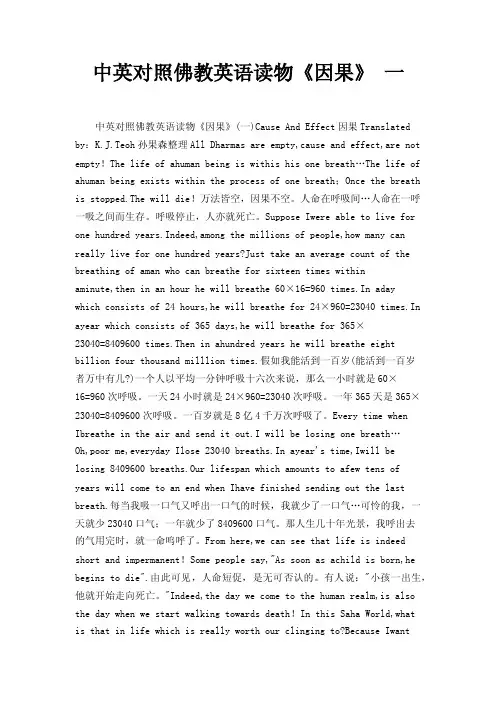
中英对照佛教英语读物《因果》一中英对照佛教英语读物《因果》(一)Cause And Effect因果Translated by:K.J.Teoh孙果森整理All Dharmas are empty,cause and effect,are not empty!The life of ahuman being is withis his one breath…The life of ahuman being exists within the process of one breath;Once the breath is stopped.The will die!万法皆空,因果不空。
人命在呼吸间…人命在一呼一吸之间而生存。
呼吸停止,人亦就死亡。
Suppose Iwere able to live for one hundred years.Indeed,among the millions of people,how many can really live for one hundred years?Just take an average count of the breathing of aman who can breathe for sixteen times withinaminute,then in an hour he will breathe 60×16=960 times.In adaywhich consists of 24 hours,he will breathe for 24×960=23040 times.In ayear which consists of 365 days,he will breathe for 365×23040=8409600 times.Then in ahundred years he will breathe eightbillion four thousand milllion times.假如我能活到一百岁(能活到一百岁者万中有几?)一个人以平均一分钟呼吸十六次来说,那么一小时就是60×16=960次呼吸。
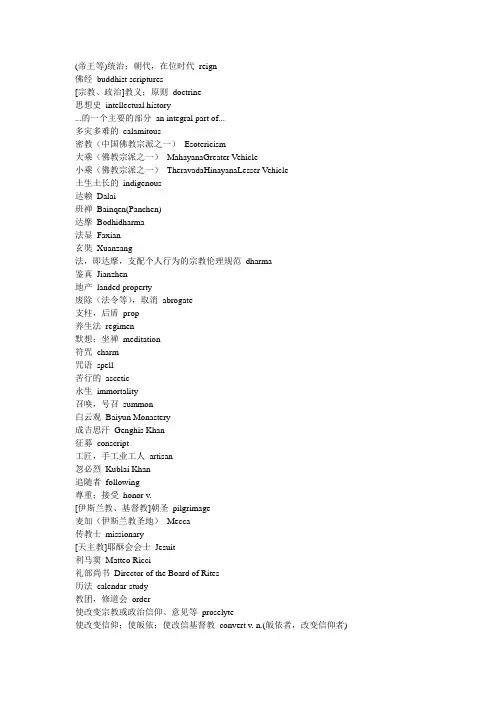
(帝王等)统治;朝代,在位时代reign佛经buddhist scriptures[宗教、政治]教义;原则doctrine思想史intellectual history...的一个主要的部分an integral part of...多灾多难的calamitous密教(中国佛教宗派之一)Esotericism大乘(佛教宗派之一)MahayanaGreater Vehicle小乘(佛教宗派之一)TheravadaHinayanaLesser Vehicle土生土长的indigenous达赖Dalai班禅Bainqen(Panchen)达摩Bodhidharma法显Faxian玄奘Xuanzang法,即达摩,支配个人行为的宗教伦理规范dharma鉴真Jianzhen地产landed property废除(法令等),取消abrogate支柱,后盾prop养生法regimen默想;坐禅meditation符咒charm咒语spell苦行的ascetic永生immortality召唤,号召summon白云观Baiyun Monastery成吉思汗Genghis Khan征募conscript工匠,手工业工人artisan忽必烈Kublai Khan追随者following尊重;接受honor v.[伊斯兰教、基督教]朝圣pilgrimage麦加(伊斯兰教圣地)Mecca传教士missionary[天主教]耶酥会会士Jesuit利马窦Matteo Ricci礼部尚书Director of the Board of Rites历法calendar-study教团,修道会order使改变宗教或政治信仰、意见等proselyte使改变信仰;使皈依;使改信基督教convert v. n.(皈依者,改变信仰者)主管教区diocese[宗]安魂弥撒requiem mass大弥撒(有烧香、奏乐等)high mass小弥撒(无烧香、奏乐等)low mass教区;教区的全体居民parish教区居民parishioner[集合词]教士;牧师(天主教神职人员,新教教职人员的统称)clergy教士,牧师clergyman[集合词](与教士、僧侣等相对的)俗人laity传播福音的evangelistic金陵协和神学院Nanjing Union Theological Seminary[法]规定;条款provision入教仪式admittance rites布达拉宫Potala Palace人民代表deputy to the People's Congress(学术)讨论会、座谈会symposium命运、天命destiny儒家思想Confucianism孝道filial piety国教state religion教规canon公民有信仰宗教的自由和不信仰宗教、宣传无神论的自由。
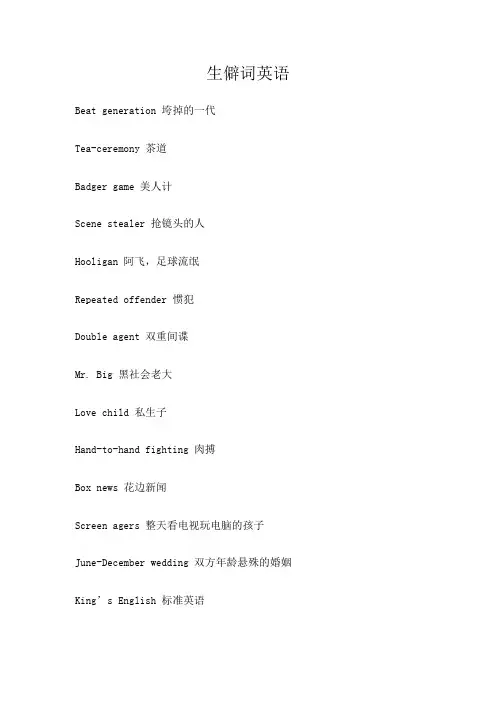
生僻词英语Beat generation 垮掉的一代Tea-ceremony 茶道Badger game 美人计Scene stealer 抢镜头的人Hooligan 阿飞,足球流氓Repeated offender 惯犯Double agent 双重间谍Mr. Big 黑社会老大Love child 私生子Hand-to-hand fighting 肉搏Box news 花边新闻Screen agers 整天看电视玩电脑的孩子June-December wedding 双方年龄悬殊的婚姻King’s English 标准英语Leap day/year 闰日2.29/年366 Maid of Orleans 圣女贞德Narrow squeak(口)九死一生的脱险Ninja turtle 忍者神龟Poet laureate 桂冠诗人Ponytail 马尾辫Protestant 新教徒Pulitzer Prize 普利策奖Rat race 激烈的竞争Red-light district 红灯区Reader’s Digest 读者文摘Russian roulette 俄罗斯轮盘赌Sexual harassment 性骚扰Short fuse 易怒的脾气Soft-soap 奉承讨好Silent contribution 隐名捐款Silly money 来路不明的钱Silver screen 银幕,电影界Summer complaint 夏季病,拉肚子Tenth-rate 最低等的,劣等的Vertical/lateral thinking 纵向,横向思维Wide-body 大部头的作品Wheel of life (佛教)轮回Xenomania 媚外Yearbook 年鉴年刊Zen 禅Paparazzi 狗仔队Show people 娱乐界人士Exotic dance 脱衣舞Bearish 行情下跌的Bullish 行情上涨的State prisoner 政治犯Stowaway 偷渡者,逃票的乘客Plainclothesman 便衣警察Police dog 警犬Police post 派出所Negligent homicide 过失杀人Impostor 江湖骗子ICJ International Court of Justice 国际法院Espionage 间谍间谍活动Lifer 职业军人Mine 地雷水雷Panzer 装甲车坦克Off limits 军事禁区Q-boat 伪装成商船或渔船的武装船只Riot corps 防暴部队Standing army 常规军Sniper 狙击手Bermuda Triangle 百慕大三角洲Brain drain 脑力人才外流Brawn drain 劳力外流Break- dancing 霹雳舞French windows 落地窗Funeral home 殡仪馆Taillight 车尾灯Visiting team 客队Runner-up 亚军Black referee 黑哨Foul play 犯规动作Standing broad jump 立定跳远Underachiever 差等生Hothouse 对儿童进行学前教育Whiz kid 神童优等生Newsbreak 重要新闻Needle trade 成衣业Massage parlour 挂按摩牌子的妓院Moonlight 作动词,干第二职业Mixed marriage 异族通婚Moon roof 汽车的顶窗Egghead 对知识分子的蔑称Dog days 七八月份的酷暑期,伏天Connoisseur 鉴赏家Box office 票房Bridesmaid 女傧相Bee (美)为互助友好而举行的聚会Bigtime 红极一时的,赫赫有名的Bank of issue 发行银行Cater ∏ 美国总统克林顿(卡特二世。
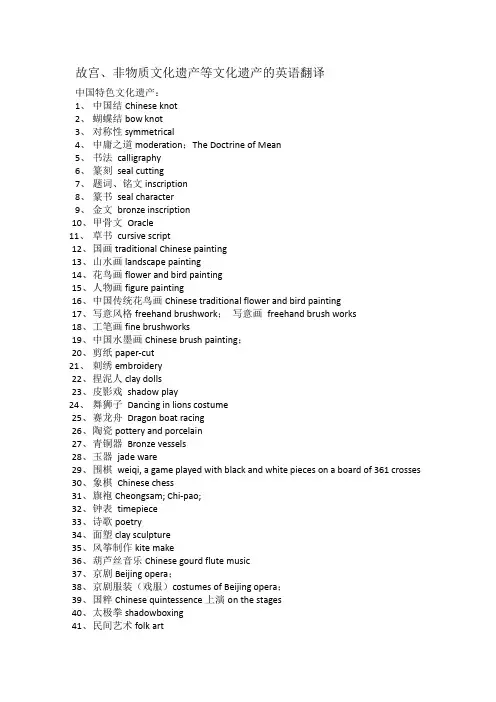
故宫、非物质文化遗产等文化遗产的英语翻译中国特色文化遗产:1、中国结Chinese knot2、蝴蝶结bowknot3、对称性symmetrical4、中庸之道moderation;The Doctrine of Mean5、书法calligraphy6、篆刻seal cutting7、题词、铭文inscription8、篆书seal character9、金文bronze inscription10、甲骨文Oracle11、草书cursive script12、国画traditional Chinese painting13、山水画landscapepainting14、花鸟画flower and birdpainting15、人物画figure painting16、中国传统花鸟画Chinese traditional flower and bird painting17、写意风格freehand brushwork;写意画freehand brush works18、工笔画fine brushworks19、中国水墨画Chinese brush painting;20、剪纸paper-cut21、刺绣embroidery22、捏泥人clay dolls23、皮影戏shadow play24、舞狮子Dancing in lions costume25、赛龙舟Dragon boat racing26、陶瓷pottery and porcelain27、青铜器Bronze vessels28、玉器jade ware29、围棋weiqi, a game played with black and white pieces on a board of 361 crosses30、象棋Chinese chess31、旗袍Cheongsam; Chi-pao;32、钟表timepiece33、诗歌poetry34、面塑clay sculpture35、风筝制作kite make36、葫芦丝音乐Chinese gourd flute music37、京剧Beijing opera;38、京剧服装(戏服)costumes of Beijing opera;39、国粹Chinese quintessence上演on the stages40、太极拳shadowboxing41、民间艺术folk art42、皮影戏leather-sihouette show43、手艺craft44、手工艺术品hand-made45、工艺美术品Handicraft Articles46、石碑stone tablet47、象形文字pictograph48、雕刻engraving49、木雕wood carvings50、古式建筑ancient architecture51、木质建筑wooden architecture52、卯榫结构tenon structure53、汉Chinese满Manchu 藏Tibetan54、中华文化的瑰宝Reasure of Chinese culture55、历史文化遗产the historical and cultural heritages56、非物质文化遗产intangible cultural heritage57、儒家confucian58、道家Taoism;the Taoist School59、法家Legalism;the Legalist School60、佛教Confucianism; the Confucian School61、吉祥龙凤形象Auspicious Dragon and Phoenix Image62、洪荒之力prehistorical powers; mystic energy故宫特色:1、故宫the Palace Museum2、紫禁城the Forbidden City3、皇家宫殿imperial palace4、武英殿Hall of Martial Valor5、中和殿Hall of Central Harmony6、文华殿Hall of Literary Harmony7、文渊阁Pavilion of Literary Source8、《清明上河图》Riverside Scene at Qingming Festival9、大都会艺术博物馆Metropolitan Museum of Art10、云纹盘Moire porcelain dish11、青玉云龙纹炉Sapphire dragon tattoo furnace12、明沈周《雏鸡图页》Ming Shen Zhou 、the chicken page13、C loisonne enamel furnace branch lotus patterns around the elephant掐丝珐琅缠枝莲纹象耳炉14、金瓯永固杯JinOu Gong GuBei15、《平复帖》Healed copybook16、B aoCai Qi outline in gold Pavilion - style fairy birthday Royal timepiece from theOpen Group钟表之宝彩漆描金楼阁式自开门群仙祝寿御制钟17、M ao Shen Zibo tapestry weaving and embroidery The Magpies may map织绣之宝沈子蕃缂丝《梅鹊图》18、Bronze treasure alley Avon bottles青铜之宝酗亚方樽19、W ear of ceramic kiln treasure franc red glaze with a straight mouth bottles陶瓷之宝郎窑红釉穿带直口瓶20、塔门Tap Mun21、水墨丹青Watercoler Painting22、云纹漆案(复制品)Lacquer Tray with Cloud Design (duplicate)23、Chinese use chop-sticks , bowls , spoons and plates .中国人使用筷子、碗、瓷匙和瓷盘。
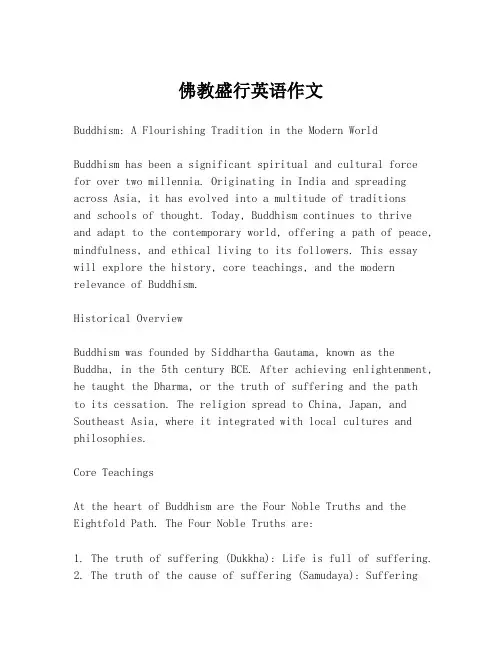
佛教盛行英语作文Buddhism: A Flourishing Tradition in the Modern WorldBuddhism has been a significant spiritual and cultural force for over two millennia. Originating in India and spreading across Asia, it has evolved into a multitude of traditionsand schools of thought. Today, Buddhism continues to thrive and adapt to the contemporary world, offering a path of peace, mindfulness, and ethical living to its followers. This essay will explore the history, core teachings, and the modern relevance of Buddhism.Historical OverviewBuddhism was founded by Siddhartha Gautama, known as the Buddha, in the 5th century BCE. After achieving enlightenment, he taught the Dharma, or the truth of suffering and the pathto its cessation. The religion spread to China, Japan, and Southeast Asia, where it integrated with local cultures and philosophies.Core TeachingsAt the heart of Buddhism are the Four Noble Truths and the Eightfold Path. The Four Noble Truths are:1. The truth of suffering (Dukkha): Life is full of suffering.2. The truth of the cause of suffering (Samudaya): Sufferingis caused by craving and attachment.3. The truth of the end of suffering (Nirodha): It is possible to end suffering.4. The truth of the path leading to the end of suffering (Magga): The Eightfold Path is the way to end suffering.The Eightfold Path consists of right understanding, right intention, right speech, right action, right livelihood,right effort, right mindfulness, and right concentration. These principles guide Buddhists towards a life of wisdom, ethical conduct, and mental discipline.Modern RelevanceIn today's fast-paced world, Buddhism offers a unique approach to personal development and societal harmony. The practice of mindfulness, derived from Buddhist meditation, has become a popular method for managing stress and promoting mental health. Moreover, the Buddhist emphasis on compassion and non-violence resonates with the global need for peace and understanding.Adaptation and GrowthBuddhism has shown remarkable adaptability. It has adopted new forms, such as Engaged Buddhism, which combines spiritual practice with social activism. Additionally, the advent of technology has allowed Buddhist teachings to reach a wider audience through online platforms and digital resources.ConclusionBuddhism's enduring appeal lies in its timeless wisdom andits ability to address contemporary issues. As a religion and a philosophy, it continues to provide a framework for ethical living, personal growth, and spiritual development. With its emphasis on inner peace and universal compassion, Buddhism remains a flourishing tradition in the modern world, offering insights and practices that are as relevant today as they were centuries ago.。
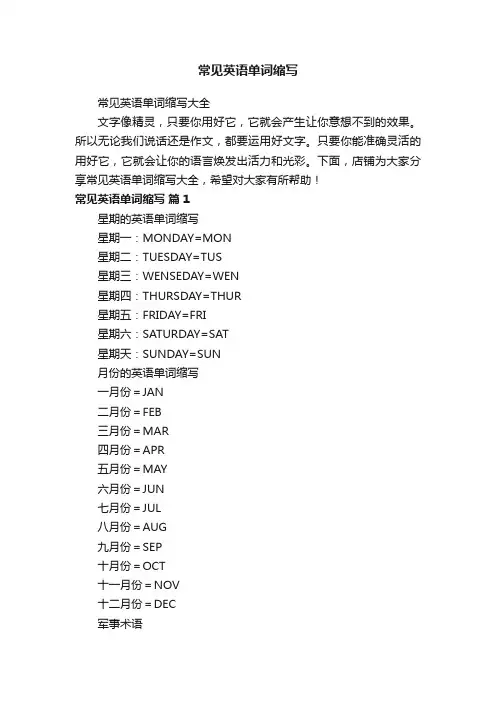
常见英语单词缩写常见英语单词缩写大全文字像精灵,只要你用好它,它就会产生让你意想不到的效果。
所以无论我们说话还是作文,都要运用好文字。
只要你能准确灵活的用好它,它就会让你的语言焕发出活力和光彩。
下面,店铺为大家分享常见英语单词缩写大全,希望对大家有所帮助!常见英语单词缩写篇1星期的英语单词缩写星期一:MONDAY=MON星期二:TUESDAY=TUS星期三:WENSEDAY=WEN星期四:THURSDAY=THUR星期五:FRIDAY=FRI星期六:SATURDAY=SAT星期天:SUNDAY=SUN月份的英语单词缩写一月份=JAN二月份=FEB三月份=MAR四月份=APR五月份=MAY六月份=JUN七月份=JUL八月份=AUG九月份=SEP十月份=OCT十一月份=NOV十二月份=DEC军事术语USMC=海军陆战队NAVY=海军AF=AIRFORCE(空军)ARMY=陆军宗教类C=CHRISTIANISMJ=JUDAISM(犹太教)C=CATHOLICISM(天主教)B=BUDDHISM(佛教)I=ISLAMNR=NOREFERENCE(没有宗教信仰)星座水瓶座:AQUARIUS(1月21日-2月19日)双鱼座:PISCES(2月20日-3月20日)白羊座:ARIES(3月21日-4月20日)金牛座:TAURUS(4月21日-5月21日)双子座:GEMINI(5月22日-6月21日)巨蟹座:CANCER(6月22日-7月23日)狮子座:LEO(7月24日-8月23日)处女座:VIRGO(8月24日-9月23日)天秤座:LIBRA(9月24日-10月23日)天蝎座:SCORPIUS(10月24日-11月22日)人马座:SAGITTARIUS(11月23日-12月21日)山羊座:CAPRICORNUS(12月22日-1月20日)常见英语单词缩写篇21. cata-表示“向下,相反,离开”2. deca-表示“十”3. deci-表示“十分之一”4. demi-表示“半”5. endo-表示“内部”6. hecto-表示“百,许多”7. hemi-表示“半”8. hepta-表示“七”9. hexa-表示“六”10. holo-表示“全部”11. intra-表示“在内,内部”12. iso-表示“等,同”13. kilo-表示“一千”14. meta-表示“超过,改变”15. milli-表示“千,千分之一”16. ob-表示“逆,倒,加强意义”17. octa-表示“八”(亦作octo)18. penta-表示“五”19. quadri-, quadru-表示“四”20. quasi-表示“类似,准”21. semi-表示“半”22. sept,septi-表示“七”23. sex-表示“六”24. step-表示“后,继或前夫(妻)所生”25. stereo-表示“立体”26. supra-表示“超….”27. tetra-表示“四”28. tri-表示“三”29. twi-表示“二,两”30. uni-表示“一个,单一”31. vice-表示“副”32. with-表示“向后,相反”第三部分通过词根认识单词(常用词根一)1. acid, acri, acrid, acu=sour, sharp,表示“尖,酸,锐利”2. act=to do , to drive,表示“行动,做”3. aer, aero, aeri=air,表示“空气,充气”等4. ag=do, act,表示“做,代理做”5. agri, agro, agr=field, land,表示“田地,农业”等6. alter, altern, ali=other, to change,表示“其他的,改变状态”7. am, amor, amat=love,表示“爱,情爱”8. ambul=walk,表示“行走,走路”9. anim=life,spirit,表示“生命,精神”等10. ann, enn=year,表示“年,一年”11. anthrop=man,human,表示“人,人类”12. apt,ept=fit, ability,表示“适应,能力”13. aqu=water,表示“水”14. arch,archy=ruler, rule, chief,表示“统治者,统治,主要的”15. art=skill, joint, trick,表示“技巧,关节,诡计”16. astro,aster=star,表示“星星”17. audi,audit=hear,表示“听”18. av,avar, avi=desire,bird,表示“渴望,鸟”19. ball,bol=throw, dance, ball,表示“抛,舞,球”20. bas,base=low, foundation,表示“低下,基础”21. bell,bel=war, fight,表示“战争,打斗”22. bio,bi=life,表示“生命,生物”23. brev, bridg=short,表示“短,缩短”24. cad, cas, cid=fall,表示“落下,降临”25. cand=white,glow,表示“白,发光”26. cant,cent=sing,song,表示“唱,歌”27. cap, capt, cept ,ceive, cip, cup=take, hold, seize,表示“拿,抓,握住”28. cap, cipit=head,表示“头”29. card, cord=heart,表示“心脏,一致”30. carn=flesh,表示“肉”31. ced, ceed, cess=go,表示“行走,前进”(附加) cept=take拿取32. celer=quick,speed,表示“快,速”33. cent=hundred,表示“一百”34. centr=center,表示“中心”35. cern, cert, cret=sure, separate,表示“搞清,区别”36. chron=time,表示“时间”37. cid,cis=cut,kill,表示“切开,杀”38. circ,cycl=ring,circle,表示“圆,环”39. cit=quote,call,表示“引用,唤起”40. claim, clam=cyrout, shout,表示“呼喊,叫喊”41. clear, clar, clair=clear, bright,表示“清楚,明白”42. clin, cliv=lean,slope,表示“倾斜,斜坡”43. clos, clud, clus=close,表示“关闭”44.corp,corpor=body,表示“身体,团体”"45.cracy=rule,表示“统治或政体”;crat=ruler,表示“统治者”46.creed,cred=believe,trust,表示“相信,信任47.cre,creas=grow,make,表示“增长,产生”48.cruc,crus,crux=cross,表示“十字形,交叉”49.crypt=secret,hidden,表示“秘密,隐藏”50.cub,cumb=lie down,表示“躺”;cumber=barrier,表示“躺的东西,障碍”51cult=till,表示“耕种,培养”52.cur=care,表示“关心”53.cur(r),curs, cours=run ,表示“跑,发生”54dem(o)=people,表示“人民,人们”55.dent=tooth,表示“牙齿”56.derm,dermat =skin,表示“皮肤”57.dict,dic=say,assert,表示“说话,断言”"58.dign=worthy,noble,表示“值得,高贵”59.doc,doct=to teach,表示“教”60.don,dit=give,表示“给予”61.du,dub,doub=two,表示“二,双”62.duc,duct=lead,bring,表示“引导,带来”63.dur=last,hard,表示“持久,坚硬”64.dyn,dynam=power,表示“力量”65.em,empt,ampl=take,procure,表示“拿,获得”66.equ,equi=equal,even,表示“相等,平均”67.erg=energy,work,表示“能量,活动”68.err=wander,mistake,表示“漫游,犯错误”69.ev=age,表示“年龄,时代”70.fabl,fabul=speak,表示“讲,说”71.fac,fic=face,表示“脸,面”72.fac,fact,fect,fic,fig=make,do,表示“做,制作”73.fall,fail,fault=err,deceive,表示“犯错误,欺骗”"74.fer=bring,carry,表示“带来,拿来”75.ferv=boil,表示“沸,热”76.fid=trust,faith,表示“相信,信念”77.fin=end,boundary,表示“结束,范围”78.flam,flagr=blaze,表示“火焰”79.flect,flex=bend,表示“弯曲”80.flict=strike,表示“打击”81.flor,flour=flower,表示“花”82.flu=flow,表示“流动”83.fore,fort=storng,表示“强大,力量”84.form=shape,表示“形状”85.fract=break,表示“打碎”86.frig,friger=cold,表示“冷”87.fug=flee,表示“逃,离开”88.fus=pour,表示“流,泻”89.gen,gener,genit=birth,produce,表示“出生,产生”90.gest,gister=carry,bring,表示“带来,产生”"91.gnos(t),gnor=know,表示“知道”92.gon=angle,表示“角”93.grad=step,grade,表示“步,级”94.graph,gram=write,表示“写,图”95.grat,gree=pleasing,表示“感激,高兴”96.grav,griev=heavy,表示“重"97.greg=group,表示“群体”98.gress=.go,walk,表示“行走”99.gyn,gynec=woman,表示“妇女”100.habit=dwell,表示“居住”101.hap=chance,表示“机会,运气”"102.her,hes=stick,表示“粘附”"103.hibit=hold,表示“拿住”"104.hum=earth,表示“土,地”"105.hydy,hydro= water,表示“水”"106.idea,ideo=idea,表示“思想,观点”"107.it=go,表示“行走”"108.ject=throw,cast,表示“投掷,扔”"109.judg,judic=judge,表示“判断”"110.junct,join=join,表示“结合,连接”"111.jur,juris=swear,law,表示“发誓,法律”" 112.juven=young,表示“年轻”"bor=labor,表示“劳动”"ps=slip,表示“滑,滑走”"t= bring,out,表示“拿出,带出”"v,luv,lut=wash,表示“洗,冲洗”"117.lect,lig= choose,gather表示“选择,收集”" 118.lect,leg=speak,read,表示“讲,读”" 119.leg,legis=law,表示“法律”"120.lev,live=raise,lighten,表示“提高,举起,变轻”"121.liber=free,表示“自由”"122.limin,lim=threshold,表示“门槛,限制”"123.line=line,表示“直线,线条”"124.lingu=language ,表示“语言”,原意为“舌头”" 125.liter=letter,表示“文字,字母”"126.lith=stone,表示“石头”"127.loc=place,表示“地方”"128.log,logu=speak,表示“说话”"129.log=science,表示“科学,学科”"130.long=leng,表示“长”"131.loqu,locu=speak,表示“说话”"132.luc,lust=light,shine,表示“光,照亮”"133.lumin=light,表示“光”"134.lud,lus=play,表示“玩,戏剧”"135.man, manu= hand,表示“手”"136. marin=sea,表示“海洋”"137.mark= sign ,表示“记号,符号”"138.matern, matr= mother,表示“母性,母亲”"139.med=middle,表示“中间”"140.memor=memory,表示“记忆”"141.ment= mind,表示“思考,神智”"142.merg, mers= sink,表示“沉,没”"143.meter,metr,meas,mens=measure,表示“计量;测量等”144.migr=remove,表示“迁移”"145.min=project,表示“伸出,突出”"146.mini,min=small,表示“小”"147.mir =wonder,look,表示“惊奇,看”"148. misc=mix,表示“混淆”"149. miss,mit= send,cast,表示“送,放出”"150. mob=move,表示“动”"151.mod=mode,manner,表示“方式,模式,风度”" 152.mon, monit= warn,表示“警告”"153.morph=form,shape,表示“形状”"154.mort=death,表示“死”"155.mot= motion,表示“运动”"156.mount=ascend,表示“登上”"157. muni,mun= public,表示“公共的”"158.mut= change,表示“改变”"159. nat=born,表示“出生的”"160. nav,naus, naut= ship,表示“船” naut引申为“海员”161. nect,nex= bind,表示“连结”"162.neg=deny,表示“否认”"163. negr, nigr= black,表示“黑”"164. noc, nox= hurt, poison,表示“伤害,毒”"165.nom(y)=a field of knowledge,表示“某一领域的知识”166.nomin=name,表示“名称,名字”"167.norm=rule, norm,表示“规则,规范”"168. not=know,表示“知道,注意”"169.nounce,nunci= speak,表示“讲话,说出”"170. nov=new,表示“新的”171. numer=number,表示“数目”"172. onym=nam,表示“名字”"173. oper=work ,表示“工作”"174. opt= choose,表示“选择”"175. opt,opto= sight,表示“视力”"176. ora,orat=mouth,表示“嘴,说”"177. ori,orig= rise, begin ,表示“升起,开始”"178. ordin=order,表示“命令,顺序”"179. orn=embellish,表示“装饰”"180.par=equal,表示“平等”"181. part, port=part, divide,表示“部分,分开”"182. pass=pass through,表示“通过”"183. pass= felling,表示“感情”"184.path=feeling, suffering, illness,表示“感情,痛苦,病”"185. patr(i)=father,表示“父亲”"186. ped=foot,表示“脚”"187.ped=child, education,表示“儿童”,引申为“教育”"188. pel,puls= drive, push,表示“驱动,推”"189. pen,pun=penalty,表示“处罚”"190. pend, pens= hang,表示“悬挂”"191. pend,pens, pond= weight, expend,表示“称重量,称银子”,引申为“花费”"192.per=try,表示“尝试”"193.pet=seek,表示“追寻,寻求”"194.phag=eat,表示“吃”"195.phil,philo=love,表示“爱”"196. phob,phobia=dislike,表示“厌恶”"197.phon=sound,表示“声音”"198. pict=paint,表示“描画”"199.plac=to please,表示“取悦,使满意,使平静”"200.plat= flat,表示“平坦”"201. plant=plant,表示“种植”"202. ple,plen,plet, pli=full, fill,表示“满,填满”"203.plex= fold,表示“重叠”"204.plic, pli, ply= fold ,表示“重叠,折叠”"205.plor=cry,weep,表示“喊,哭”"206.point,punct= point,make sharp,表示“点,变尖”"208.pon, pound= put,表示“放置”"209. popul,publ=people,表示“人民”"210. port=carry,表示“拿,运”"211. pos, posit=put,表示“放”"212. prais, preci= value,表示“价值”"213. prehens, prehend= catch ,表示“抓住”"214. press= press,表示“挤压”"215. prim= first, chief,表示“第一,主要的”"216. pris= take,表示“拿住,抓住”"217. priv=single, alone,表示“单个”"218. prob, prov= test,表示“测试,证明”"219. proper,propri = one's own,表示“拥有”;引申为“恰当的”220. pugn=fight,表示“打斗”"221. pur, purg=pure,表示“纯洁”"222.put =think,表示“认为,思考”"223.quest,quir, quis, quer= seek, search,表示“寻求,询问”224. quiet, qui= still,表示“静”"225. quit= free,表示“自由”"226. radic= root,表示“根”"227.range=rank,表示“排列,顺序”"228.rap,rapt,rav=snatch,表示“捕,夺”"229.ras, rad=scrape,表示“刮擦”"230.rect=stright, right,表示“正,直”"231. rid, ris= laugh,表示“笑”"232. rod, ros= bite,表示“咬”"233. rog=ask,表示“要求,问”"234. rot= wheel,表示“轮子,转”"235. rud= rude,表示“原始,粗野”"236.rupt=break,表示“断裂”"237. sal= salt,表示“盐”"238. san, sanit= healthy,表示“健康的”"239. sanguin= blood ,表示“血”"240.sati,satis,satur=enough,full of food,表示“足够;饱足”"241.scend, scens, scent=climb,表示“爬,攀”"242.sci=know,表示“知道”"243.scrib,script=write,表示“写”"244. secut,sequ= follow,表示“跟随”"245. sect,seg= cut, divide,表示“切,割”"246. sens, sent =feel,表示“感觉”"247. sen=old,表示“老”"248. sert=join, ,表示“加入,插入”249. serv=serve, keep ,表示“服务,保持”"250. sid=sit,表示“坐”"251. sign=mark,表示“记号,信号”"252. simil, simul, sembl =alike,same ,表示“相类似,一样”" 253. Sinu=bend,表示“弯曲”"254. Sist= stand,表示“站立”"255. soc=companion,表示“同伴”,引申为“社会”" 256. sol=alone,表示“单独”"257. sol=sun ,表示“太阳”"258. solv,solu, solut=loosen,表示“松开”"259. somn=sleep,表示“睡眠”"260.son=sound,表示“声音”"261. soph=wise,表示“智慧,聪明”"262.speci=look, kind,表示“外观,种类”"263. spect, spic= look, see,表示“看”"264. sper=hope,表示“希望”"265. spers= scatter,表示“散开”"266. spir=breathe,表示“呼吸”"267. spond, spons =promise,表示“承诺”"268. st, sta, stat, stan, stant, stin = stand,表示“站,立”" 269. stell=star,表示“星星”"270 still=small drop。
常用佛教名词英语翻译究竟菩提心Absolute Bodhi Citta - 完全觉醒、见到现象之空性的心;甘露Amrta (藏文dut tsi) :一种加持物,能帮助心理及生理疾病的复元。
阿罗汉Arhat (藏文Dra Chompa):已净除烦恼障的小乘修行者暨成就者。
他们是完全了悟的声闻或独觉(或称缘觉)圣者。
观音菩萨AvalOkiteSVara (藏文ChenreZig):大悲心本尊,是西藏人最广为修持的本尊,因此被尊为西藏之怙佑者。
观音菩萨的心咒是「嗡嘛呢贝美吽」,六字大明咒或六字明咒。
中阴(藏文Bardo):字义为「介于两者之间」。
中阴总共有六种,一般指的是介于死亡及再度受生之间的状态。
菩提心Bodhi Citta (藏文Chang Chup Sem):义为「开悟或证悟之心」。
菩萨Bodhi SattVa (藏文Chang Chup Sem Pa):义为「展现证悟心者」,亦指为了救度一切众生脱离轮回苦海,而誓愿修持以菩提心为基础的大乘法门及六波罗蜜的修行者。
菩萨戒Bodhi SattVa Vow (藏文Chang Chup Sem Gyi Dong Pa):修行者为了引领一切众生皆成就佛果而誓愿修行并领受的戒。
佛性Buddha Nature (梵文tathagatagarbha,藏文deshin shekpe nying po),又称为「如来藏」:是一切众生皆具有之原始本性。
开悟就是佛性的彰显,因此,佛性往往被称为佛的本质,或开悟的本质。
释迦牟尼佛Buddha Sakyamuni (藏文Shakya Tubpa):往往又称为瞿昙佛(Gautama Buddha),指贤劫千佛当中最近出世、住于公元前五百六十三年至四百八十三年间的佛。
法道Buddhist Path (藏文lam):得到正觉或证悟的过程,亦指修行的三种逻辑次第;根、道、果「」中的道。
圆满次第Completion Stage (藏文dzo rim):在金刚乘,禅修有两个阶段:生起次第及圆满次第。
1Buddhism is one of the world's major religions, with a profound history and significant influence. It originated in ancient India around the 6th to 5th century BCE. The founder of Buddhism was Siddhartha Gautama, who later became known as the Buddha.In those ancient times, India was a land of diverse philosophies and spiritual quests. Siddhartha Gautama, born into a privileged life, was deeply disturbed by the suffering he witnessed in the world. He embarked on a spiritual journey, seeking answers and liberation from the cycle of birth and death.After years of intense meditation and self-reflection, Siddhartha Gautama attained enlightenment under a Bodhi tree. This momentous event marked the birth of Buddhism. His teachings emphasized the Four Noble Truths - the truth of suffering, the cause of suffering, the cessation of suffering, and the path to the cessation of suffering.The early spread of Buddhism was not an easy path. It faced various challenges and opposition, yet it gradually gained followers and influence. Monks and disciples carried the teachings far and wide, spreading the message of compassion, wisdom, and liberation.Buddhism's appeal lay in its profound understanding of the humancondition and its offer of a way to overcome suffering and achieve inner peace. Over time, it evolved and diversified, adapting to different cultures and regions, but always retaining its core principles.In conclusion, the origin of Buddhism in ancient India and the enlightenment of its founder, Siddhartha Gautama, have had a lasting impact on countless lives and continue to inspire people around the world to seek spiritual growth and inner wisdom.2Buddhism, one of the world's major religions, has a profound and captivating origin. Its emergence was deeply rooted in the social and cultural context of ancient India. At that time, the society was marked by strict caste divisions and various forms of suffering and injustice.The founder of Buddhism was Siddhartha Gautama, also known as Buddha. Born into a privileged life, he was shielded from the hardships of the outside world. However, upon encountering the realities of old age, sickness, and death, he was profoundly shaken and embarked on a spiritual quest to seek the truth and liberation from suffering.Through years of intense meditation and self-reflection, Buddha gained profound insights into the nature of human existence and the causes of suffering. He realized that desire and ignorance were the root causes of suffering and advocated the Middle Path, a balance between extreme indulgence and extreme asceticism.Unlike some other religions, the origin of Buddhism was not based on divine revelation but on the individual's direct experience and realization of truth. Buddha's teachings emphasized personal effort and inner transformation rather than relying solely on external deities.His teachings spread rapidly, attracting followers from all walks of life. Buddhism offered a path of hope and liberation to those oppressed by the societal norms and hardships of the time.In conclusion, the origin of Buddhism and the life and contributions of its founder have had a lasting impact on millions of people throughout history, providing a guiding light in the pursuit of spiritual enlightenment and a more compassionate and peaceful world.3Buddhism, one of the world's major religions, has a profound and rich history. Its origin can be traced back to ancient India. During that time, there was a great deal of cultural and intellectual exchange. Different philosophies and beliefs competed and interacted, laying the foundation for the emergence of Buddhism.The founder of Buddhism was Siddhartha Gautama, known as the Buddha. He was born into a privileged life but was deeply disturbed by the suffering he witnessed. This led him to embark on a spiritual quest for the truth and the means to end suffering.The core teachings of the Buddha, such as compassion, wisdom, andthe Middle Way, have had a lasting impact. Compassion means having empathy and kindness towards all living beings. Wisdom involves understanding the nature of reality and the causes of suffering. The Middle Way refers to avoiding extremes and finding a balanced path in life.According to Buddhist scriptures, the origin of Buddhism is marked by the Buddha's enlightenment under the Bodhi tree. This event is considered a pivotal moment, where he gained profound insights into the nature of existence and the way to liberation from suffering.Buddhism has spread far and wide over the centuries, influencing countless lives and shaping the cultures and societies where it has taken root. It continues to offer solace, guidance, and a path to spiritual growth for people of all backgrounds.4Buddhism, one of the world's major religions, has a profound and complex origin. The emergence of Buddhism was not an isolated event but was closely related to various factors in ancient society. Politically, the social unrest and frequent wars in those times led people to seek spiritual solace and a way out of the chaos. Economically, the disparity between the rich and the poor and the exploitation of the common people gave rise to a yearning for equality and justice.The founder of Buddhism, Siddhartha Gautama, also known as Buddha Shakyamuni, had a tremendous influence. His teachingsemphasized the pursuit of enlightenment and the end of suffering. His philosophy of the Four Noble Truths and the Eightfold Path provided a clear path for people to overcome the cycle of birth and death and achieve spiritual liberation.Modern scholars have conducted in-depth research on the origin of Buddhism. They have explored the historical and cultural background of its emergence, analyzed the interaction between Buddhism and other religions and philosophies of the time, and studied its subsequent spread and evolution.The influence of Buddha's teachings extends far beyond the religious realm. It has had a profound impact on the social and cultural aspects of many countries. It has promoted values such as compassion, wisdom, and non-violence, and has inspired people to pursue inner peace and a harmonious society.In conclusion, the origin of Buddhism and the influence of its founder are of great significance. They not only provide spiritual nourishment for believers but also contribute to the diversity and development of human civilization.5Buddhism, one of the world's major religions, has a profound and fascinating origin. It originated in ancient India around the 6th to 5th century BCE. The founder of Buddhism was Siddhartha Gautama, laterknown as Gautama Buddha.The birth of Buddhism was not an accident but a response to the spiritual and social needs of that time. In a society marked by class divisions and spiritual unrest, people were seeking answers and solace. Buddhism provided a path to inner peace and enlightenment.From the perspective of its origin, we can see how religion acts as a source of comfort for the human soul. It offers a refuge from the hardships and uncertainties of life, providing hope and a sense of purpose.When comparing Buddhism with other mainstream religions, such as Christianity and Islam, we find both similarities and differences. They all strive to address fundamental questions about human existence and morality. However, their teachings, rituals, and organizational structures may vary.The wisdom of Gautama Buddha is still highly relevant in contemporary society. His emphasis on compassion, mindfulness, and the pursuit of wisdom can offer valuable insights into addressing modern problems like stress, materialism, and social inequality.In conclusion, understanding the origin and founder of Buddhism not only enriches our knowledge of history and culture but also prompts us to reflect on the significance and value of religious beliefs in shaping human civilization and individual well-being.。
常见佛教英语佛教Buddhism三大语系佛教Three languages of Buddhism:汉语系佛教Chinese Language Buddhism藏语系佛教Tibetan Language Buddhism巴利语系佛教Pali Language Buddhism大乘佛教Mahayana Buddhism上座部佛教Theravada Buddhism金刚乘/密宗Vajrayana Buddhism(Lamaism) 中国佛教Chinese Buddhism佛经Sutra经、律、论Sutras, Vinaya, Sastra大藏经Tripitaka Sutra三宝(佛、法、僧)Triratna (Buddha, Dharma,Sangha)“三宝”加被May “Triratna”bless法师Master/Venerable长老Thero/Venerable大长老Mahathero/ Most Venerable方丈/主持Abbot佛教宗派Buddhist School佛教仪式:Buddhist Ceremony/Buddhist Service for和平祈祷法会Buddhist Praying Ceremony for World Peace礼佛pay respect for Buddha颂经Sutra Chanting香炉Incense burner上香To offer incense to Buddha因果Cause and effect成道/成佛To obtain the Buddha-hood觉悟To get enlightenment三皈五戒The ceremony for lay Buddhists to go to the Buddha for refuge, go to the Dharma for refuge, go to the Sangha for refuge and to follow the five commandments of Buddhism(no killing,no stealing,no sexual misconduct,no lying,no intoxicant)诸恶莫做,众善奉行,自净其意,既是佛教“To do no evil, to do only good, to purify the will, is thedoctrine of all Buddhas”做功德To make contribution to普渡终生To save all living beings from sufferings四谛Four noble truths八正道Eight noble paths善哉Sadhu (good or excellent)佛教寺院Monastery/Buddhist Temple山门The Front Gate大雄宝殿The Main Shrine Hall圆通殿The Hall of Universal Understanding 观音殿The Hall of Avalokitesvara Buddhisatva藏经阁The Tripitaka Sutra Pavilion罗汉堂The Hall of Arhan祖师殿The Hall of Patriarch四大天王Four deva-kings, the protectors of Buddhism韦驮Vitasoka/Vigatasoka, the protector of Buddhism斋堂Monastic Dinning Hall客堂Monastic Reception四大名山:Four holy mountains of Chinese Buddhism五台山Wutai Mountain is the Holy Place of Manjusri Buddhisattva峨嵋山Ermei Mountain is the Holy Place of Mahasthama Buddhisattva九华山Jiuhua Mountain is the holy place of Ksitigarbha Buddhisattva普陀山Putuo Mountain is the holy place of Avalokitesvara Buddhisattva佛像Buddha statue释迦牟尼佛Shakyamuni Buddha弥勒佛Maitreya Buddha迦叶佛Kasyapa Buddha阿弥陀佛Amitaba Buddha毗庐舍那佛Vairocana Buddha药师佛Bhaisajya Buddha/medicine Buddha 三世佛Buddhas of Three Periods: Kasyapa Buddha of the past Shakyamuni Buddha of the present, Maitrya Buddha of the future菩萨Buddhisattva观世音菩萨Avalokitesvara Buddhisattva菩贤菩萨Samandhabatra Buddhisattva大势智菩萨Mahasthamaprapta Buddhisattva文殊菩萨Manjusri Buddisattva地藏菩萨ksitigahba Buddhisattva善财童子Sudhana罗汉Arhan西方三圣:阿弥陀佛、观音菩萨、大势至菩萨Amitaba BuddhaAvalokitesvara Buddhisattva Mahasthamaprapta Buddhisattva达摩Budhidharma摩腾Kasyapa Matanga竺法兰Gobharana/Dharmaraksa佛学院Buddhist College僧伽Sangha僧、尼(比丘、比丘尼)monk、nun /Bhiksu, Bhiksuni方丈/主持Abbot首座Chief monk监院/当家Monastic Manger侍者Assistant中国佛教协会The Buddhist Association of China中国佛学院The Buddhist Academy of China会长President副会长Vice President秘书长Secretary General副秘书长Deputy Secretary General佛学英语词汇the Great Vehicle d大乘the Lesser Vehicle 小乘the Diamond Vehicle 金刚乘Four Noble Truths 四圣谛苦suffering集causes of suffering灭suppression of suffering道path to suppression of suffering Twelve Links in the Chain of Causation 十二因缘cycle of rebirths 轮回ignorance 惑nirvana 涅磐greed 贪hatred 嗔stupidity 痴pride 慢hesitation 疑wrong view 恶见no-soul 无我impermanence 无常sentient beings 众生deva 天human 人asura 阿修罗animal 畜牲hungry ghost 饿鬼denizen of hell 地狱morality 戒concentration 定wisdom 慧action 身speech 口consciousness 意lay Buddhists 居士novice monks 沙弥monks 比丘Five Precepts 五戒personal enlightenment 自觉universal enlightenment 觉他full enlightenment 觉满Buddha of Medicine 药师佛Buddha Maitreya 弥勒佛body of essence 法身award body 报身body of transformation 化身Four Heavenly Kings 四天王karma 因果Buddha Amitaba 阿弥陀佛Buddha of Sunlight (法身佛)毗卢遮那佛Buddha Sakyamuni 释迦牟尼佛Bodhisattva of Compassion 观音菩萨Boohisattva of Ultimate Knowledge 文殊菩萨Bodhisattva of Universal Benevolence 普贤菩萨Bodhisattva of Great Power 大势至菩萨bodhi 菩提dhyana 禅那sangha 僧团saha 娑婆五蕴five aggregates色aggregate of material body受aggregate of feelings想aggregate of perceptions行aggregate of predispositions识aggregate of consciousness简单佛学英语Birth is suffering; aging is suffering;生是苦;老是苦;sickness is suffering; death is suffering;病是苦;死是苦;association with the unpleasant is suffering; 怨憎会是苦;dissociation from the pleasant is suffering;爱别离是苦;not to get what one wants is suffering;求不得是苦;in short, attachment to the five aggregates is suffering.简言之,对五蕴的执取就是苦。
When past conditioning is erased and no fresh one produced,当过去的诸行都根除了,并且也无新的产生,the mind no longer seeks for future birth.心不再企求来生。
The seed consumed, cravings no more arise. 种子耗尽,渴爱不再。
Such-minded wise ones cease like [the flame of] this lamp.智者的心有如灯熄焰灭。
Impermanent are all compounded things. 诸行无常,When one perceives this with true insight,洞察及此,then one becomes detached from suffering; 便能离苦;this is the path of purification.此即净化之道。